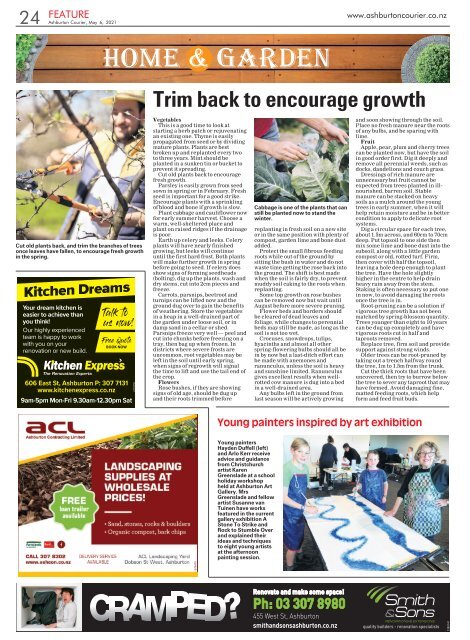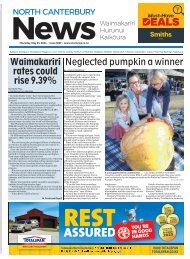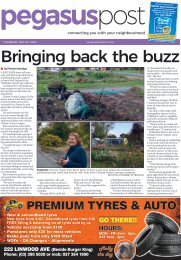Create successful ePaper yourself
Turn your PDF publications into a flip-book with our unique Google optimized e-Paper software.
FEATURE<br />
24 <strong>Ashburton</strong> <strong>Courier</strong>, <strong>May</strong> 6, <strong>2021</strong><br />
www.ashburtoncourier.co.nz<br />
HOME &GARDEN<br />
Trim back to encourage growth<br />
Cut old plants back, and trim the branches of trees<br />
once leaves have fallen, to encourage fresh growth<br />
in the spring.<br />
Kitchen Dreams<br />
Your dream kitchen is<br />
easiertoachievethan<br />
you think!<br />
Our highlyexperienced<br />
teamishappytowork<br />
withyou on your<br />
renovation or new build.<br />
The Renovation Experts<br />
Talk to<br />
us now!<br />
Free Quote<br />
BOOK NOW<br />
6<strong>06</strong> East St, <strong>Ashburton</strong> P: 307 7131<br />
www.kitchenexpress.co.nz<br />
9am-5pm Mon-Fri 9.30am-12.30pm Sat<br />
>><br />
2379550<br />
Vegetables<br />
This is agood timetolookat<br />
starting aherb patch or rejuvenating<br />
an existing one. Thymeiseasily<br />
propagated from seed or by dividing<br />
mature plants. Plants are best<br />
broken up and replanted every two<br />
to three years. Mintshould be<br />
plantedinasunkentin or bucket to<br />
prevent it spreading.<br />
Cutold plants back to encourage<br />
freshgrowth.<br />
Parsley is easily grown from seed<br />
sown in spring or in February.Fresh<br />
seed is important for agood strike.<br />
Encourage plantswith asprinkling<br />
of blood and bone if growth is slow.<br />
Plantcabbage and cauliflower now<br />
forearly summer harvest. Choosea<br />
warm,wellsheltered place and<br />
plant on raised ridges if the drainage<br />
is poor.<br />
Earthupceleryand leeks. Celery<br />
plantswill have nearlyfinished<br />
growing, but leeks will continue<br />
until thefirst hard frost. Both plants<br />
willmake furthergrowthinspring<br />
before going to seed. If celery does<br />
show signsofformingseedheads<br />
(bolting), dig up theplants, washand<br />
drystems, cut into 2cm pieces and<br />
freeze.<br />
Carrots, parsnips,beetroot and<br />
turnips can be lifted now andthe<br />
ground dug over to gain thebenefits<br />
of weathering. Store the vegetables<br />
in aheapin awelldrained partof<br />
thegarden under loose soil, or in<br />
dampsand in acellar or shed.<br />
Parsnips freeze very well —peel and<br />
cut into chunksbefore freezing on a<br />
tray,thenbag up when frozen.In<br />
districts where severe frosts are<br />
uncommon,rootvegetables may be<br />
left in the soil until early spring,<br />
whensignsofregrowth willsignal<br />
thetime to lift anduse the tail end of<br />
thecrop.<br />
Flowers<br />
Rose bushes, if they areshowing<br />
signs of old age, should be dug up<br />
and their roots trimmedbefore<br />
Cabbage is one of the plants that can<br />
still be planted now to stand the<br />
winter.<br />
replanting in freshsoil on anew site<br />
or in the samepositionwith plenty of<br />
compost, garden lime and bone dust<br />
added.<br />
Protect the small fibrous feeding<br />
roots while outofthe ground by<br />
sitting the bush in water and do not<br />
waste time getting the rose back into<br />
the ground. The shift is bestmade<br />
when the soilisfairly dry, to prevent<br />
muddysoilcakingtothe roots when<br />
replanting.<br />
Sometop growth on rose bushes<br />
can be removed now but wait until<br />
August before more severe pruning.<br />
Flowerbedsand borders should<br />
be cleared of dead leaves and<br />
foliage, while changes to perennial<br />
bedsmay still be made, as long as the<br />
soil is not too wet.<br />
Crocuses, snowdrops, tulips,<br />
hyacinthsand almost all other<br />
springflowering bulbs should all be<br />
in by nowbut alastditch effort can<br />
be madewith anemones and<br />
ranunculus, unless the soil is heavy<br />
andsunshine limited. Ranunculus<br />
gives excellent results whenwellrotted<br />
cow manure is dug into abed<br />
in awelldrained area.<br />
Any bulbs left in theground from<br />
lastseason will be actively growing<br />
and soonshowing through the soil.<br />
Place no fresh manure near theroots<br />
of any bulbs, andbesparingwith<br />
lime.<br />
Fruit<br />
Apple, pear, plum and cherrytrees<br />
can be planted now, buthave thesoil<br />
in good order first. Dig it deeply and<br />
removeall perennial weeds,suchas<br />
docks,dandelions and couch grass.<br />
Dressings of rich manure are<br />
unnecessary but fruitcannot be<br />
expected from treesplanted in illnourished,barren<br />
soil. Stable<br />
manurecan be stacked on heavy<br />
soils as amulch around the young<br />
trees in early summer, when it will<br />
help retain moisture andbeinbetter<br />
condition to apply to delicate root<br />
systems.<br />
Dig acircular space for each tree,<br />
about 1.5m across, and60cmto70cm<br />
deep. Puttopsoiltoone sidethen<br />
mix some lime and bonedust into the<br />
subsoil, along with alittle garden<br />
compost or old, rottedturf. Firm,<br />
then cover withhalfthe topsoil,<br />
leaving aholedeep enoughtoplant<br />
the tree. Have the hole slightly<br />
higher in thecentre to help drain<br />
heavy rain awayfrom thestem.<br />
Stakingis often necessary so put one<br />
in now, to avoiddamaging theroots<br />
once thetreeisin.<br />
Rootpruning can be asolutionif<br />
vigoroustree growthhas not been<br />
matched by springblossomquantity.<br />
Trees younger than eight to 10 years<br />
can be dug up completely andhave<br />
vigorousroots cutinhalfand<br />
taprootsremoved.<br />
Replacetree, firm soil and provide<br />
support againststrongwinds.<br />
Older trees canberootprunedby<br />
taking out atrench halfway round<br />
the tree, 1m to 1.5mfrom the trunk.<br />
Cutthe thick roots that have been<br />
uncovered, then try to burrow below<br />
the tree to sever any taprootthat may<br />
have formed.Avoid damaging fine,<br />
matted feeding roots, which help<br />
form and feedfruit buds.<br />
Young painters inspired by art exhibition<br />
Young painters<br />
Hayden Duffell (left)<br />
and Arlo Kerr receive<br />
advice and guidance<br />
from Christchurch<br />
artist Karen<br />
Greenslade at aschool<br />
holiday workshop<br />
held at <strong>Ashburton</strong> Art<br />
Gallery. Mrs<br />
Greenslade and fellow<br />
artist Susanne van<br />
Tuinen have works<br />
featured in the current<br />
gallery exhibition A<br />
Stone To Strike and<br />
Rock to Stumble Over<br />
and explained their<br />
ideas and techniques<br />
to eight young artists<br />
at the afternoon<br />
painting session.<br />
2380141<br />
2379479


















